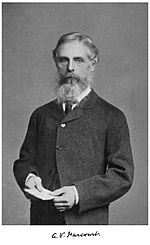Augustus George Vernon Harcourt facts for kids
Quick facts for kids
Augustus George Vernon Harcourt
|
|
|---|---|

A. G. Vernon Harcourt
|
|
| Born | 24 December 1834 London, England
|
| Died | 23 August 1919 (aged 84) St Clare, Isle of Wight, England
|
| Nationality | British |
| Alma mater | Balliol College, Oxford |
| Known for | Chemical kinetics, iodine clock reaction |
| Scientific career | |
| Fields | Physical chemistry |
| Institutions | Christ Church, Oxford |
| Doctoral advisor | Sir Benjamin Collins Brodie, 2nd Baronet |
| Doctoral students | Sir John Conroy |
Augustus George Vernon Harcourt (born December 24, 1834 – died August 23, 1919) was an important English chemist. He spent his entire career working at Oxford University. He was one of the first scientists to do careful measurements in a field called chemical kinetics. This is the study of how fast chemical reactions happen. His uncle, William Vernon Harcourt, helped create the British Association for the Advancement of Science.
Contents
About Augustus Harcourt
Augustus Harcourt was born in London in 1834. His father was Admiral Fredrick E. Vernon Harcourt. Augustus went to Harrow School and then studied Natural Science at Balliol College, Oxford. He finished his degree in 1858.
A year later, Harcourt became a chemistry teacher at Christ Church, Oxford. He worked alongside Lewis Carroll, who wrote "Alice in Wonderland." Harcourt is even mentioned in Carroll's personal diaries! He teamed up with a mathematician named William Esson. Together, they worked on many chemistry projects for over 40 years.
In 1872, Harcourt married Rachel Mary Bruce. Her father was a government official. Augustus and Rachel had two sons and eight daughters.
In 1879, Harcourt helped start a new college for women at Oxford. This college, called Somerville Hall (now Somerville College), welcomed students from all religions. His wife, Rachel, became one of its first leaders.
Harcourt stayed at Oxford until he retired in 1902. He then moved to the Isle of Wight. He passed away there in 1919.
Studying Chemical Reactions
For many years, Harcourt and William Esson studied how fast chemical reactions happen. This field is called chemical kinetics. They looked at reactions like the iodine clock reaction. In this reaction, different chemicals mix and then suddenly change color.
Their work showed that the speed of a reaction depends on how much of each chemical is present. This idea was later made into a rule called the law of mass action. This law helps scientists understand and predict how reactions will behave. They also studied the reaction between oxalic acid and potassium permanganate.
Other Inventions and Work
Harcourt also worked on other interesting projects. He invented a special device to safely give chloroform to patients. Chloroform was used to make people sleep during operations.
He also helped clean and analyze coal gas. This gas was used to light up homes and streets. Harcourt also created special lamps that burned pentane. These lamps were used as a standard to measure light brightness.
Awards and Activities
- 1863: He became a Fellow of the Royal Society. This is a very respected group of scientists.
- 1865–1873: He served as Secretary of the Chemical Society.
- 1895: He became the President of the Chemical Society.


